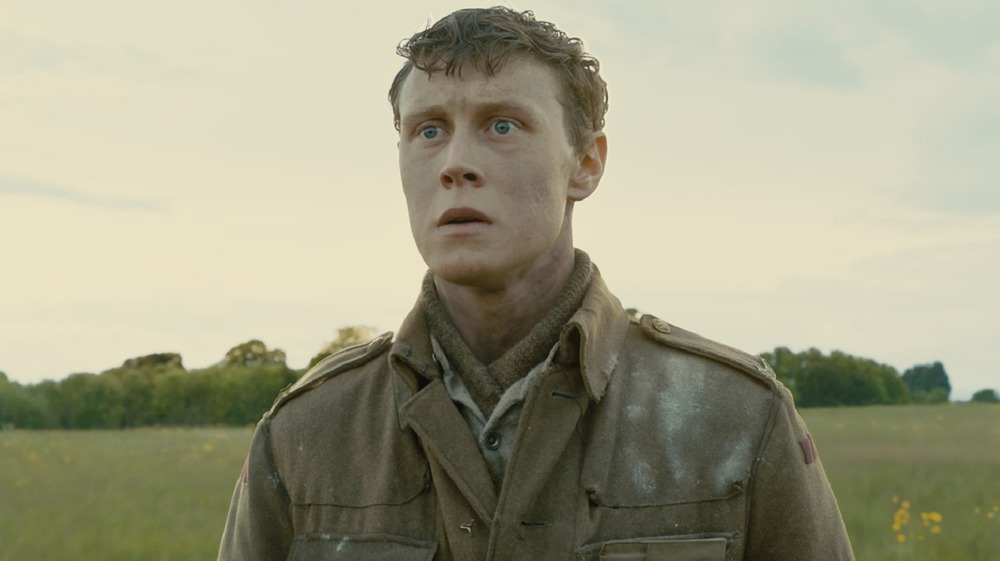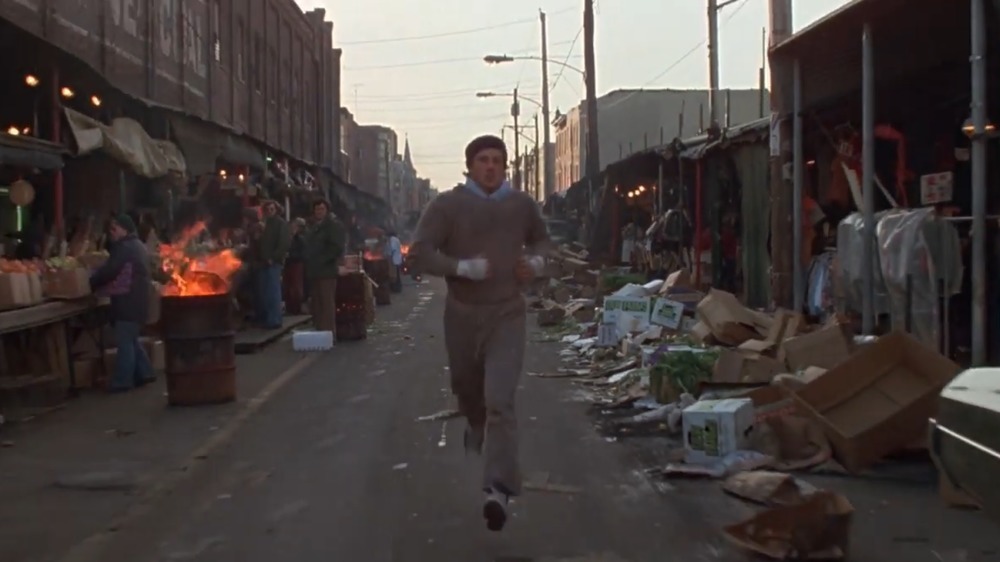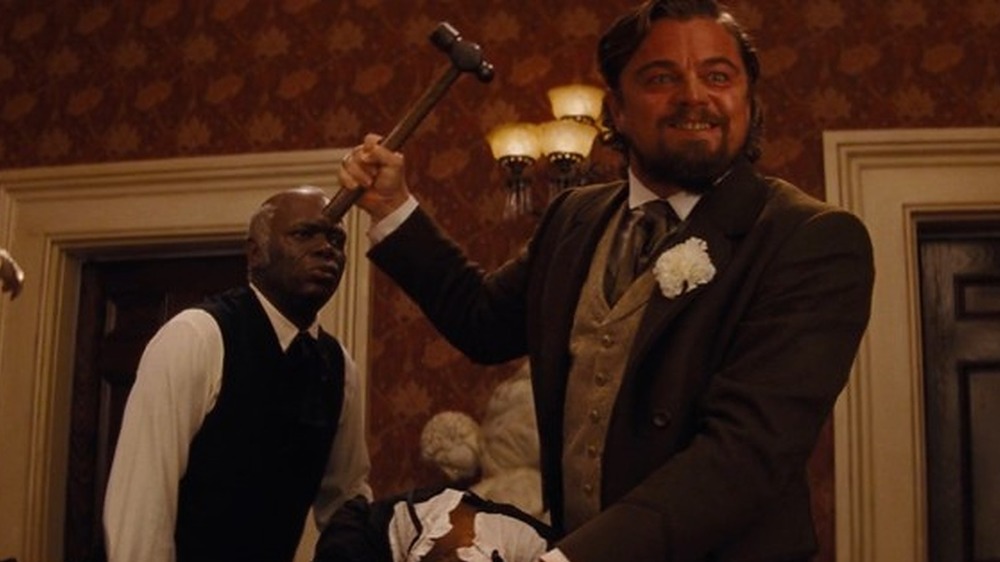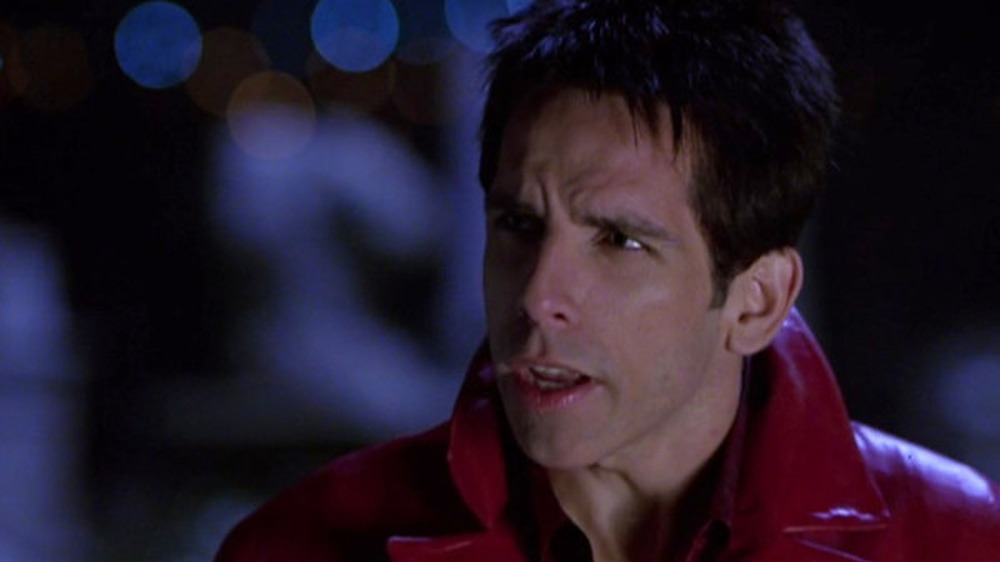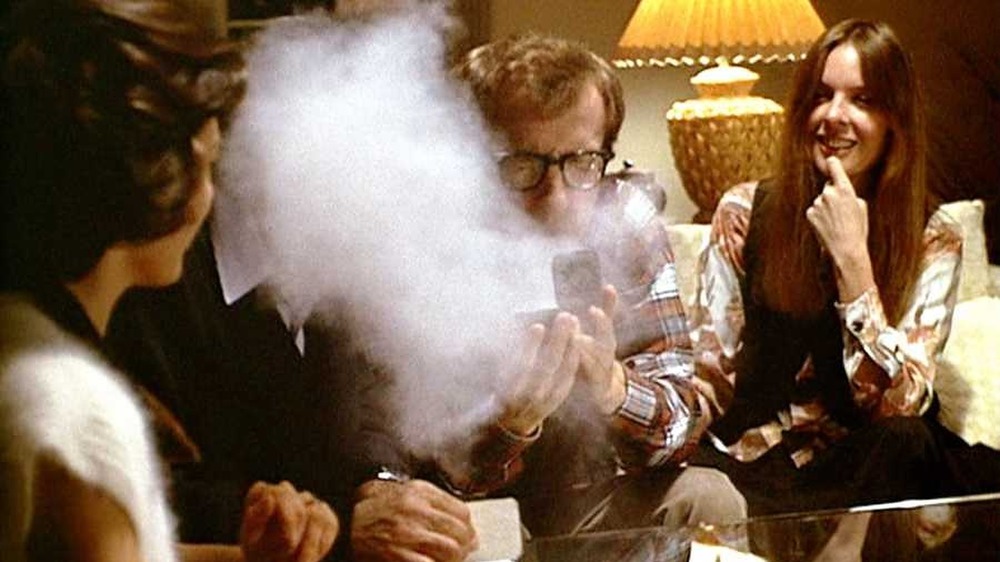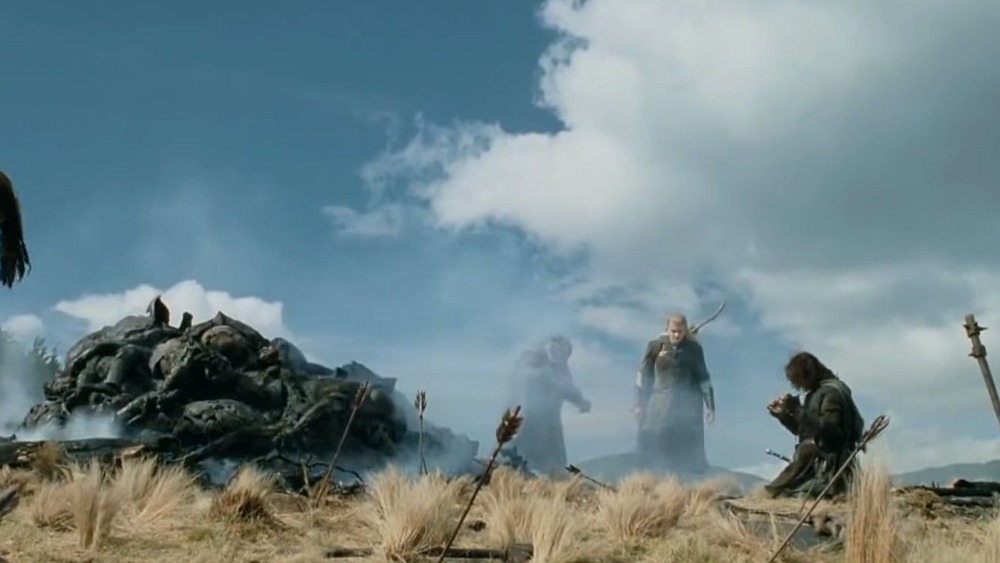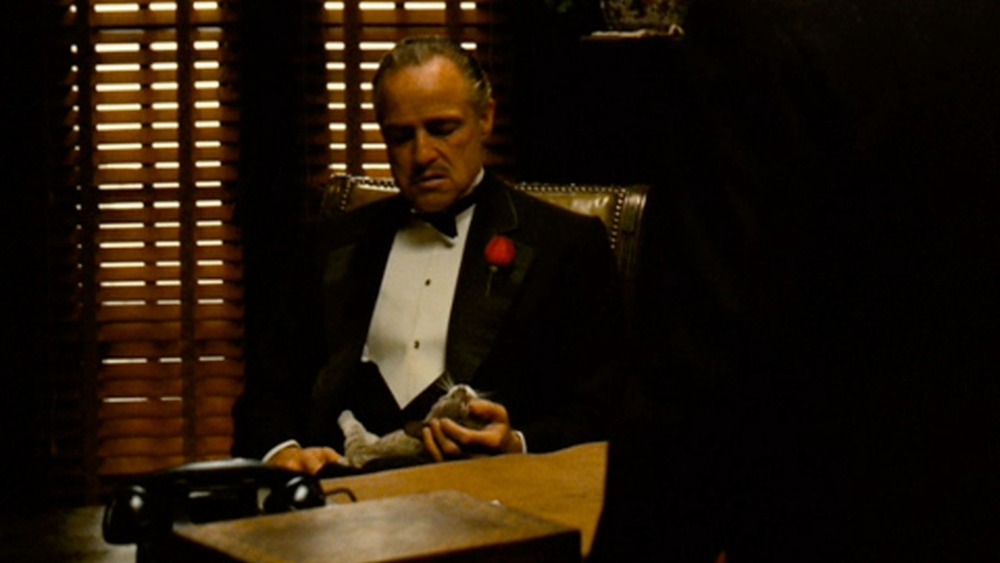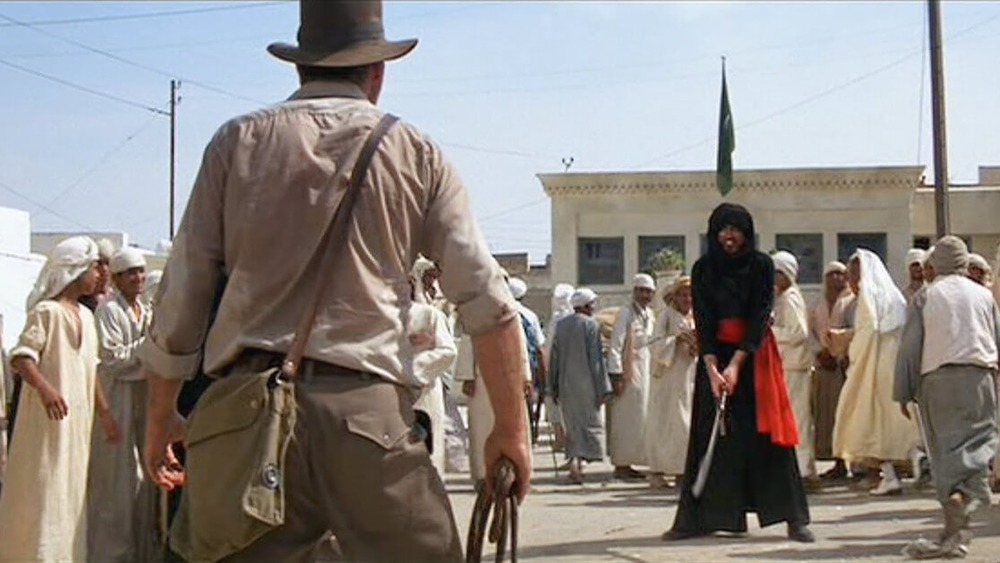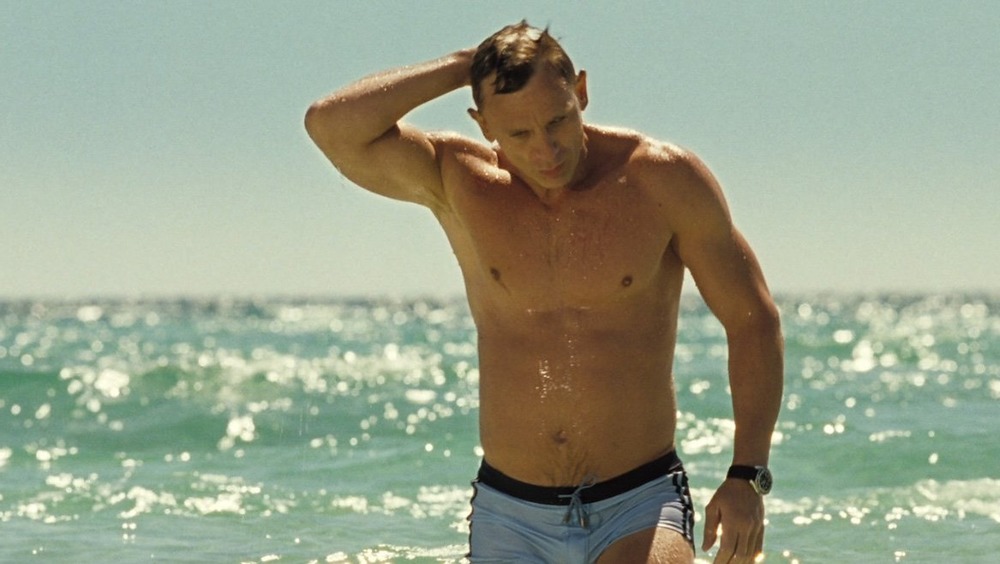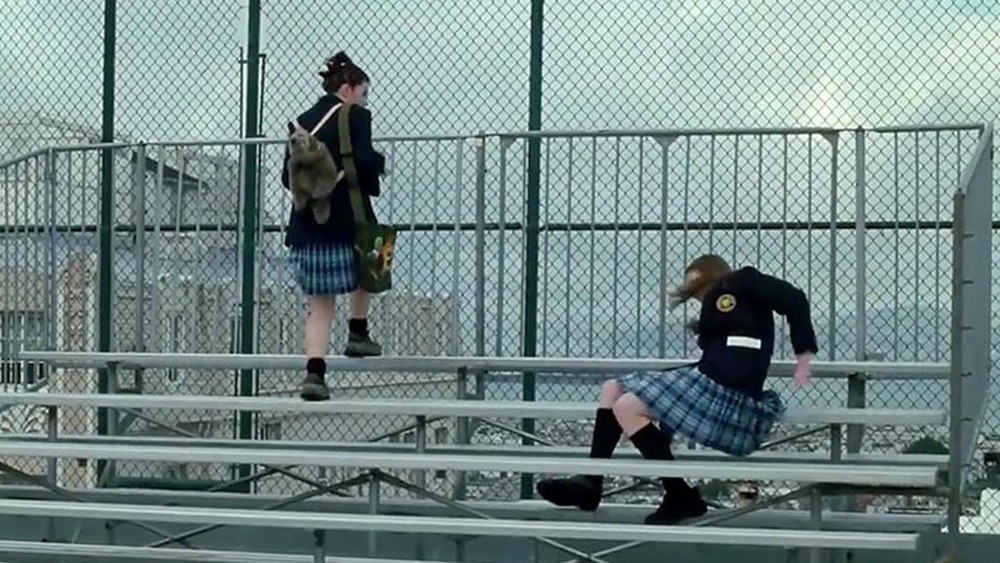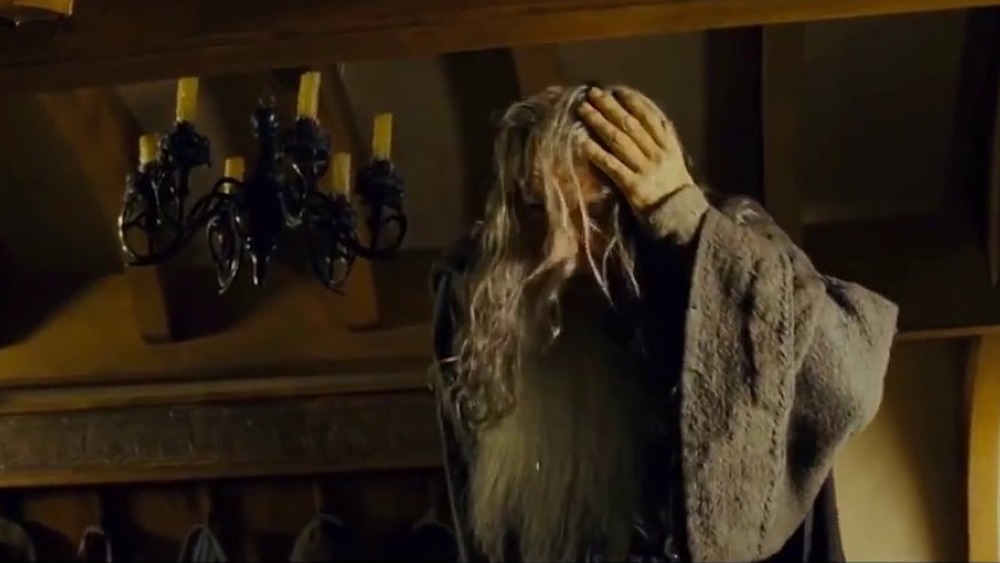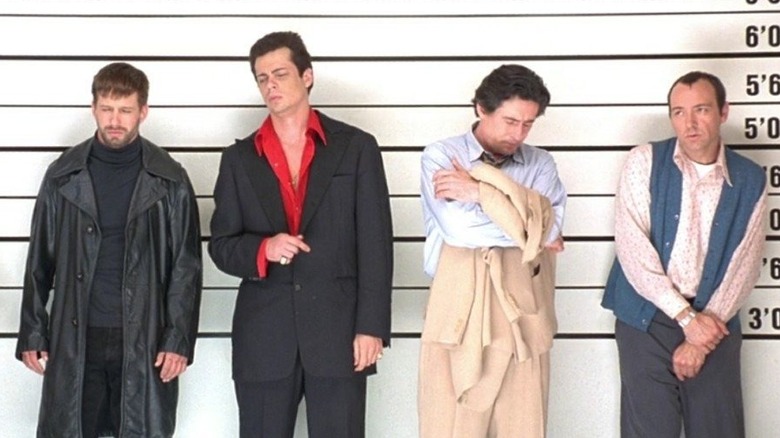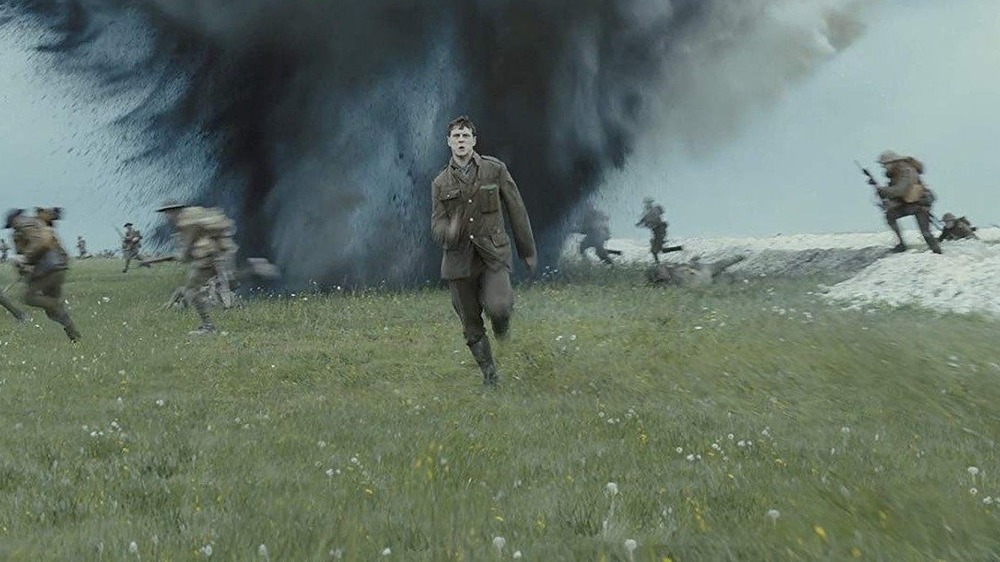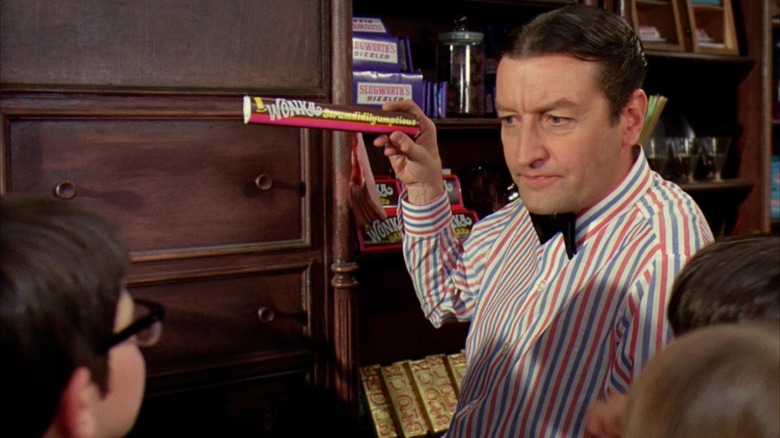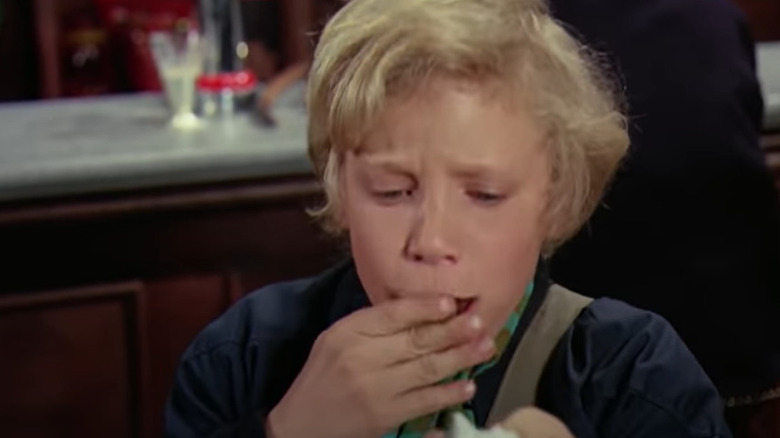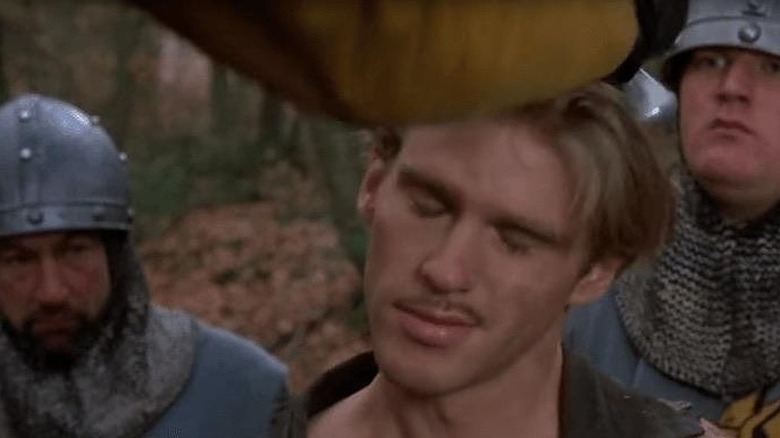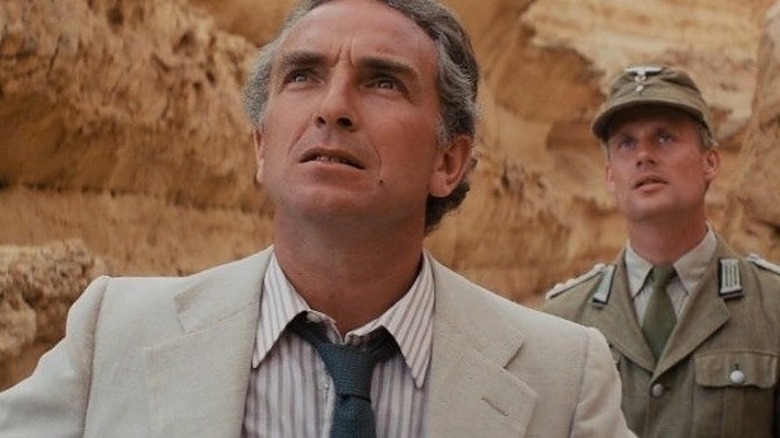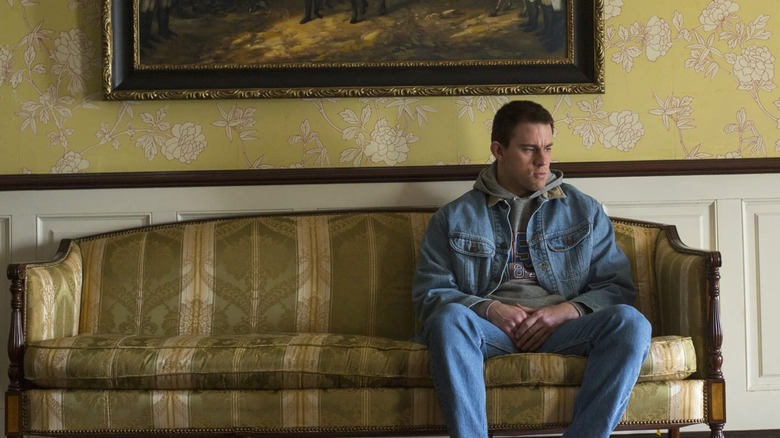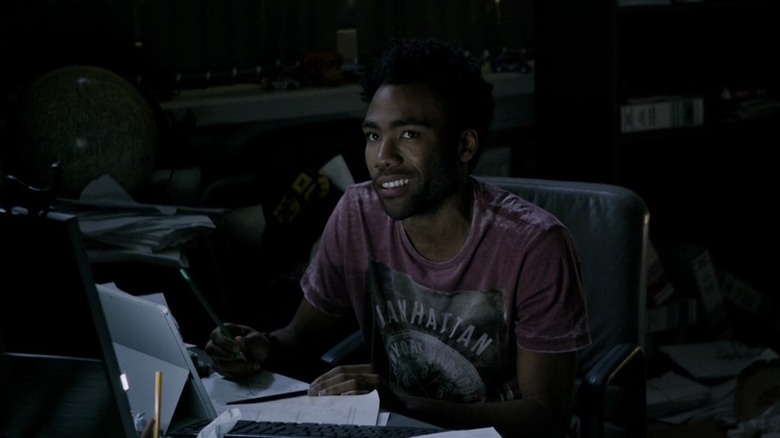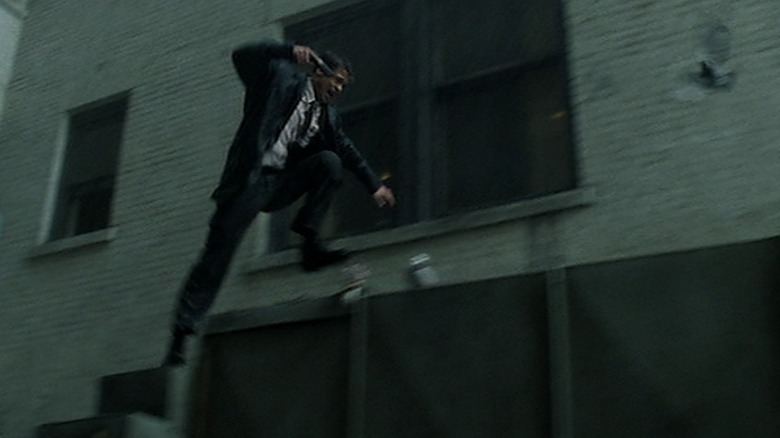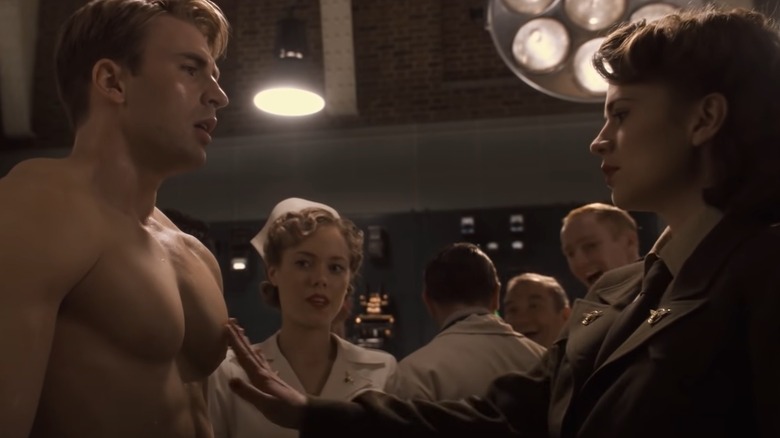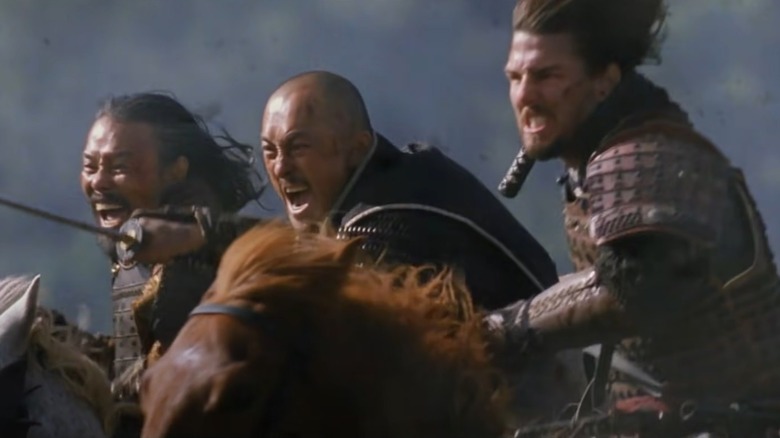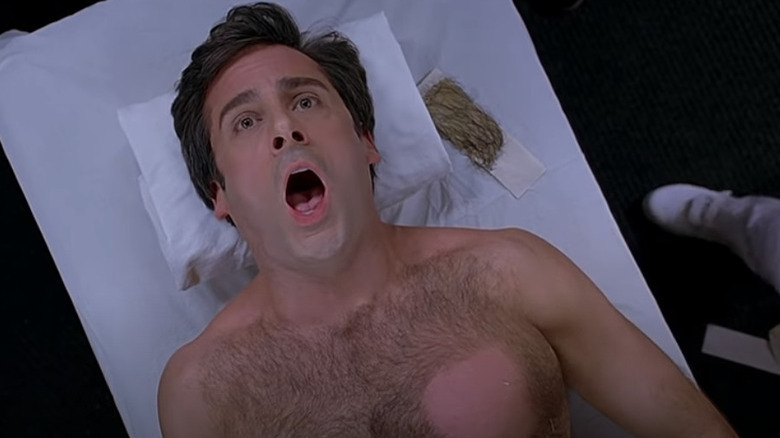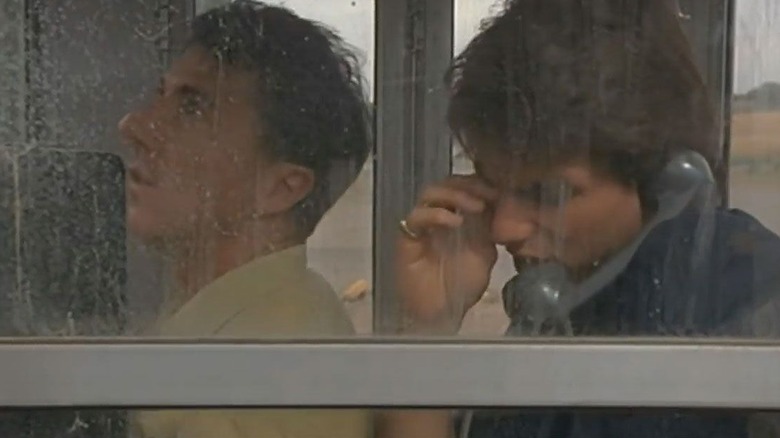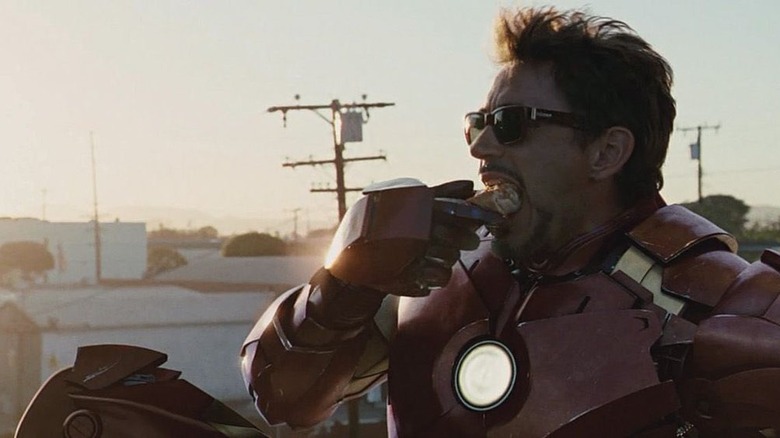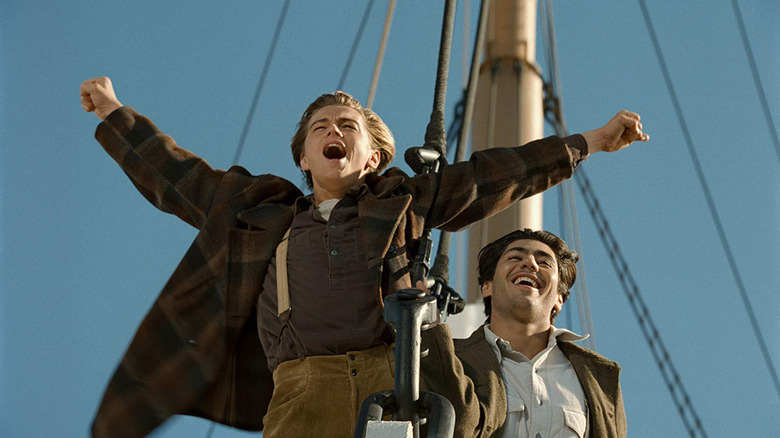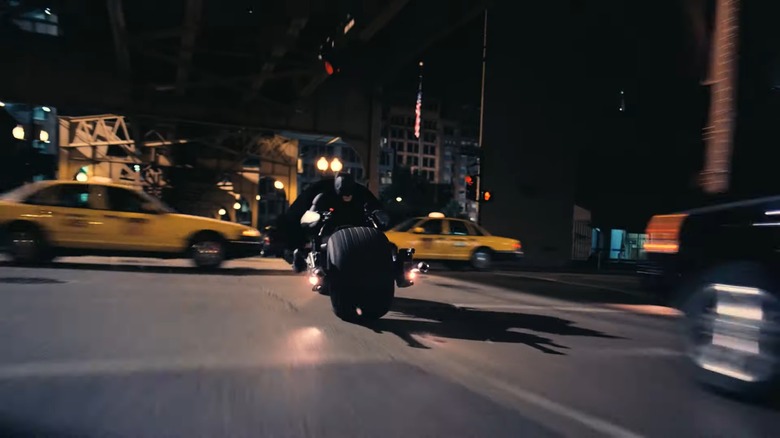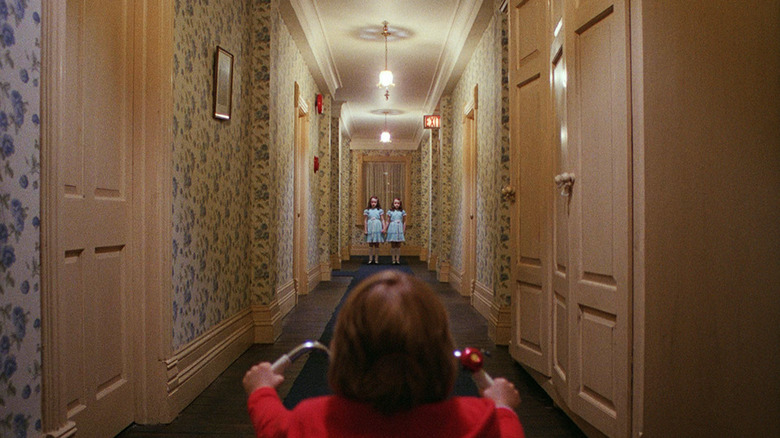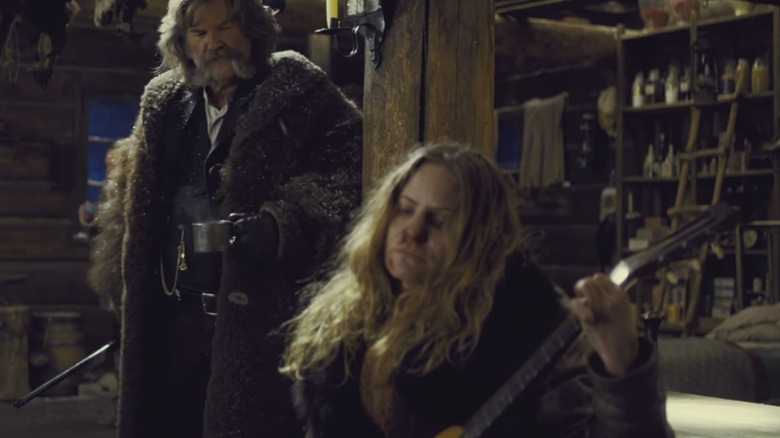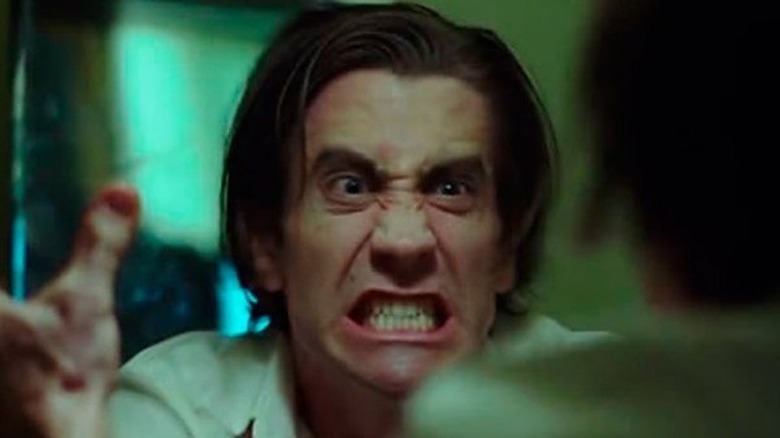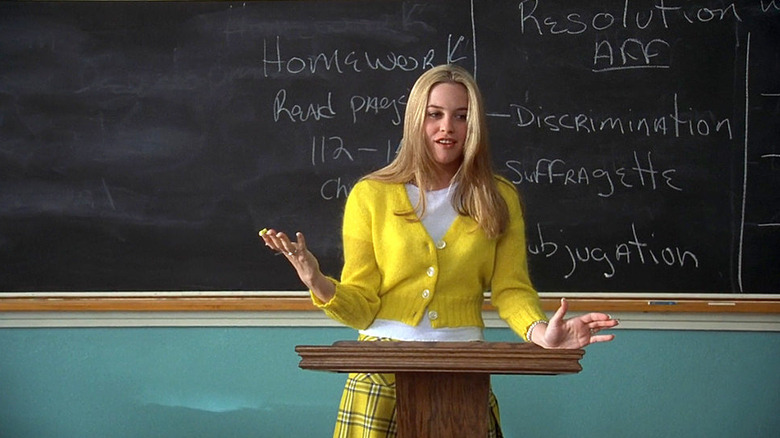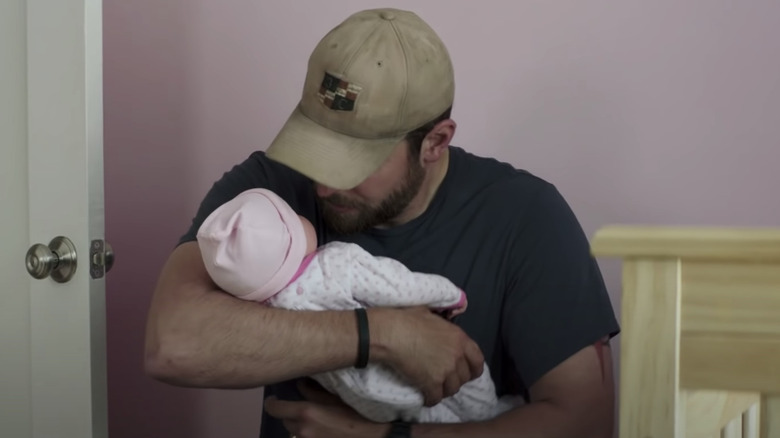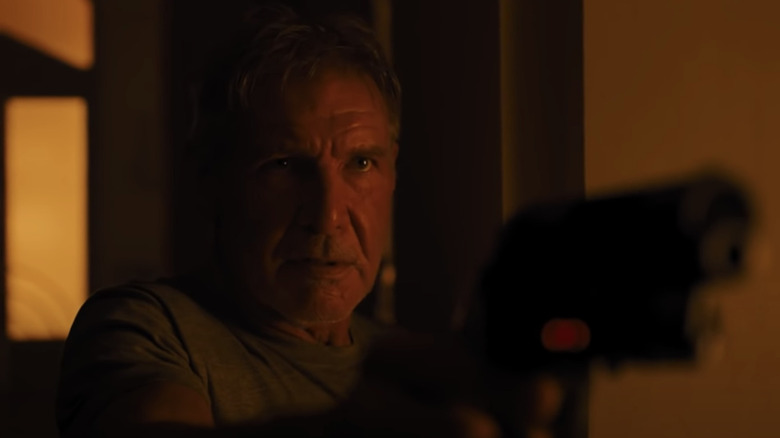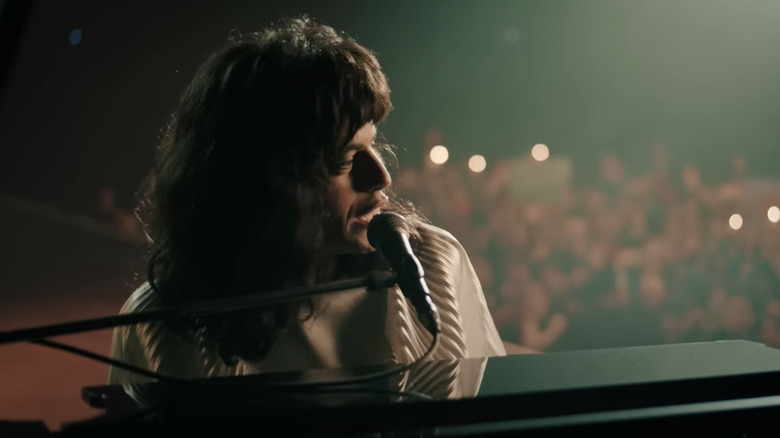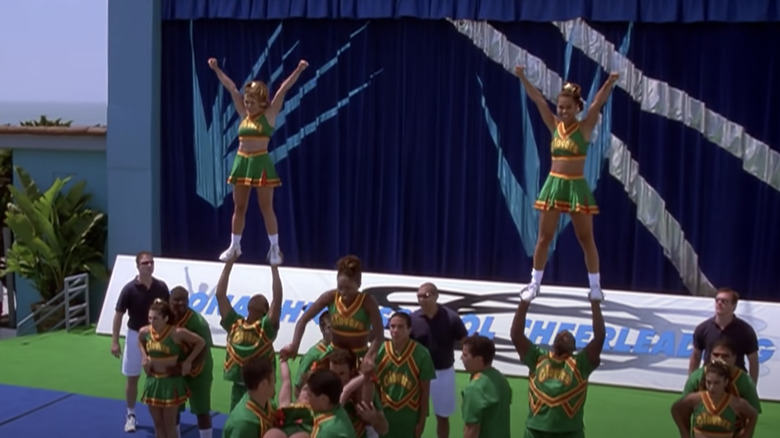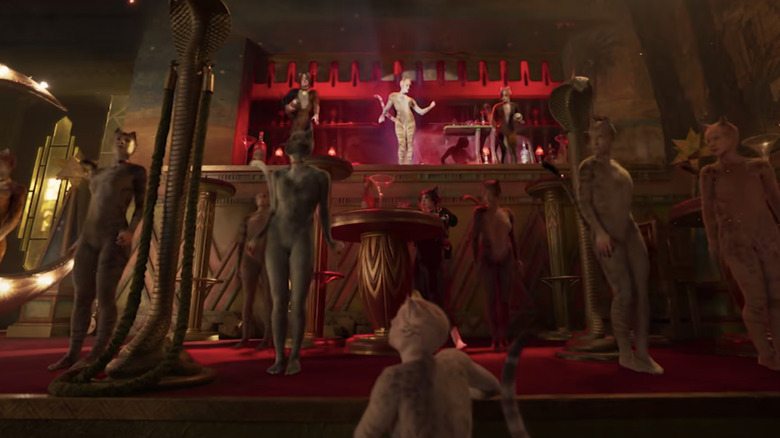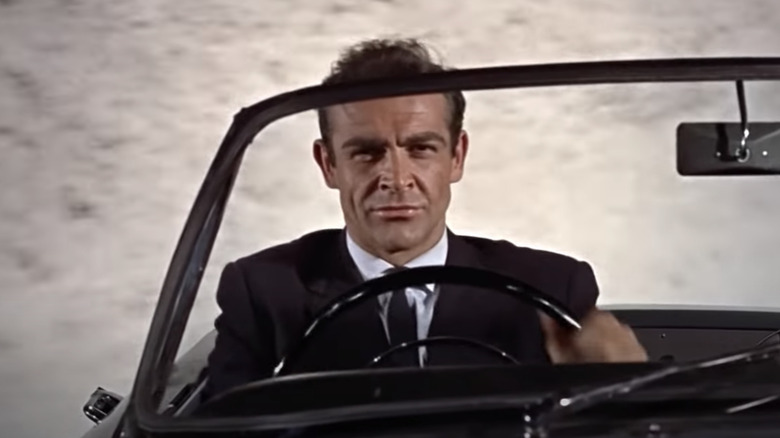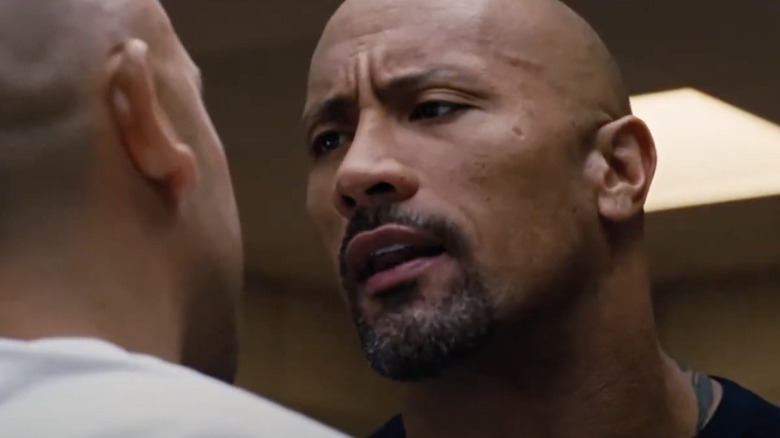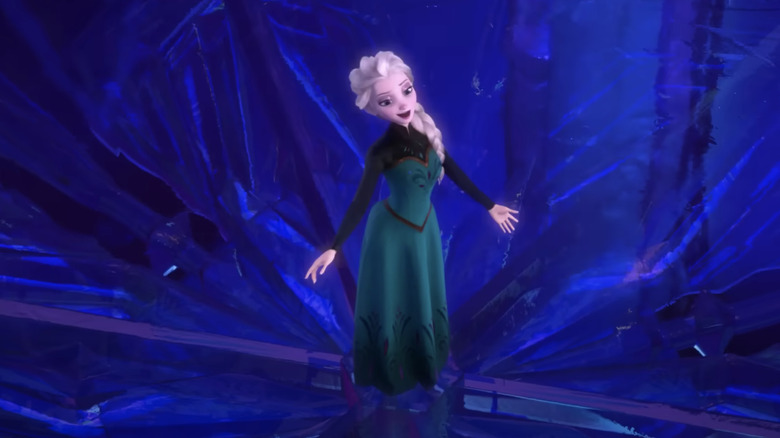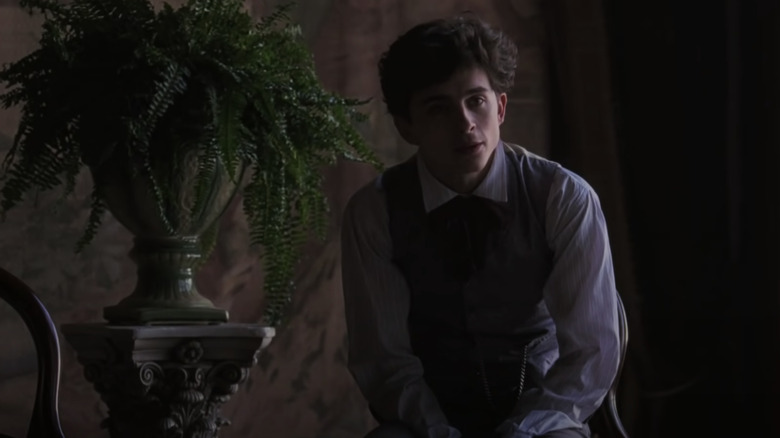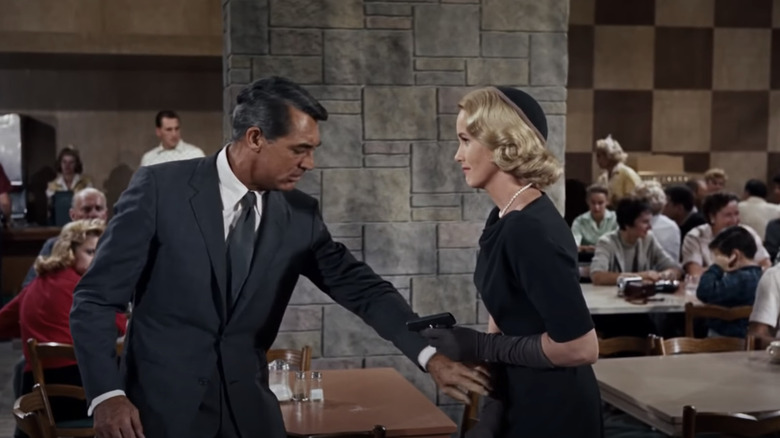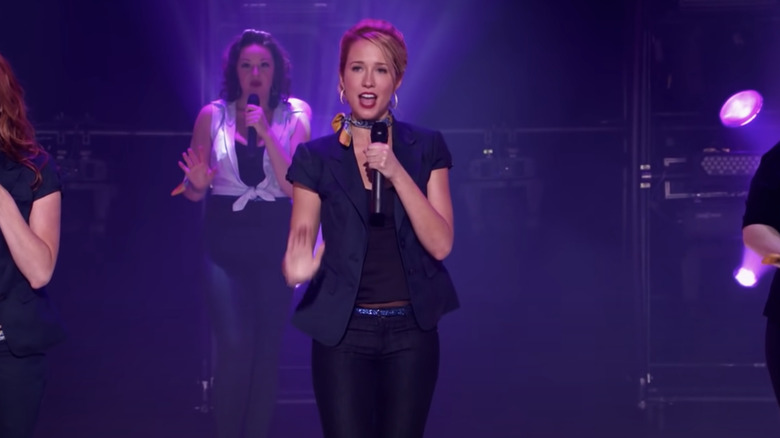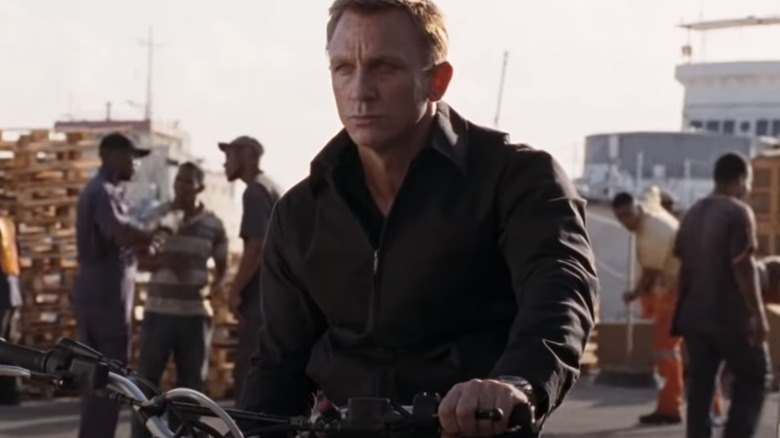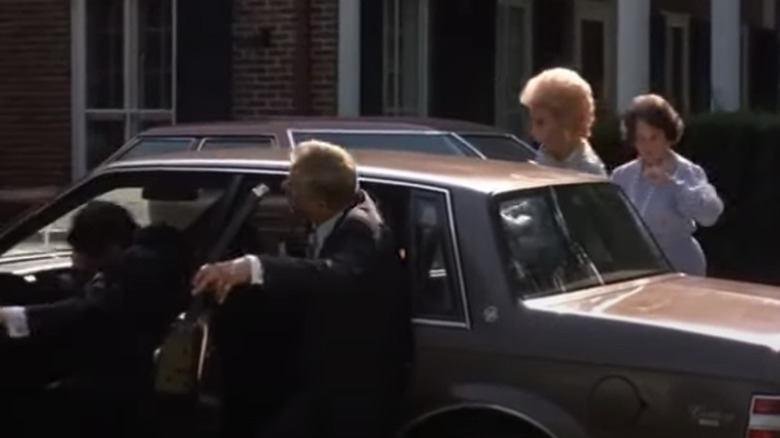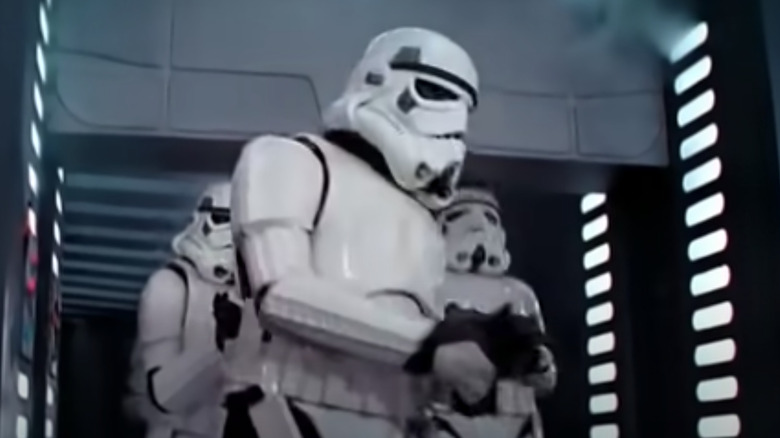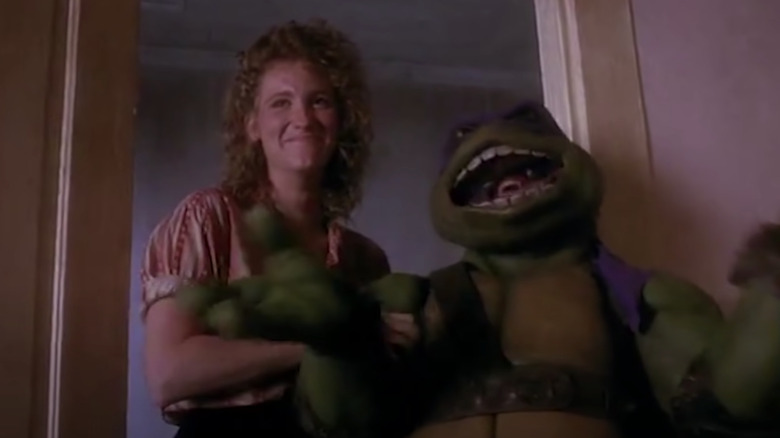Mistakes That Make These Movies Better
Forgive and forget. The old saying will tell you this is the mature way to respond when someone makes a mistake, but when it comes to some painfully perfect movie mistakes, only half of this saying is good advice. It's often true that we should forgive our favorite movies when they goof up, but forgetting is the last thing we should do. Why? Because sometimes these departures from expectations are improvements, and in certain cases, they make for some of the most unforgettable moments in cinema history. If nothing else, they actually make the films better than they would've been if everything had gone according to plan.
There are countless well-known stories of improvised lines or actions that ended up making a scene iconic. Especially in the case of seasoned veterans, sometimes the talent on set is so great that you can trust highly skilled actors to make their own call when they're forced to adapt or even just when they feel like it. Other times, there's no artistic license involved at all, and the potentially catastrophic becomes the commendable simply as a matter of fortune. The real art is in seeing a mistake as a masterpiece and having the courage to, quite literally, roll with it.
The orange toss in Rocky
Over four decades since hitting theaters, the 1976 boxing drama "Rocky" is a household name that's grown into a massive, billion-dollar franchise. Like its protagonist, though, the film was a bit of an underdog at first. The budget for the first installment was slim relative to the surrounding industry, at just above $1 million. It recouped those expenses 225 times over, but the low-budget production of the first film is still apparent in various places.
Stallone wrote the screenplay in only three and a half days, and the film was shot in just four weeks. He thought that if nothing else, the movie would show that "an unknown quantity ... can produce a diamond in the rough," no matter how the circumstances of someone's field or life are stacked against them.
The humble Italian Stallion and his creator aren't the only "unknown quantities" that made "Rocky" a hit. Because of the low budget, there wasn't always enough funding to get extras, additional cameramen, or even permits. So when they shot the popular scene of Rocky running through the Italian market, they did it "guerrilla style" from the back of a van. Because of this setup, the stall owners didn't even know there was a movie being filmed. One of them just happened to toss Stallone an orange, and he caught it — a wholesome moment that set the tone and left us rooting for the hero even harder.
DiCaprio's cut hand in Django Unchained
Leonardo DiCaprio has subjected himself to all kinds of physical torment for the sake of various roles, most notably "The Revenant" in 2015, finally earning his long-overdue Oscar. In this film, he endured freezing cold temperatures and punishing physical conditions, but he knew that these tests of both acting skill and human will were part of the role he'd agreed to take.
The masterful performer really proved his mettle, though, when he powered through an injury where no reasonable person would've expected him to. As Calvin Candie in 2012's "Django Unchained," DiCaprio played a posh and pampered plantation owner, the total opposite of the rugged trapper he portrayed in "The Revenant." But during a histrionic outburst at the dinner table, DiCaprio's character slammed his hand down, and the actor actually cut himself on a piece of glass.
Considering that the wound later required medical attention, no one would've blamed the actor for breaking character, rendering the scene unusable. But DiCaprio kept acting. This decision represented the perverse, unhinged character so well that it was left in the final cut of the movie, making for an iconic scene in which DiCaprio not only stayed in character but arguably elevated the moment.
A line flub in Zoolander
One transgression that often begs forgiveness on set is forgetfulness. The job of an actor is stressful and mentally taxing, and every so often, someone forgets their lines. Typically, though, when this happens, the director will call, "Cut!" At the very least, we don't expect these incomplete executions to make it into the actual film. The actors are supposed to refresh their lines and try again. But sometimes, forgetting one's dialogue is the most true-to-character thing an actor can do.
Of course, this is only true if you're lucky enough to play a character who's, well, a bit of an airhead. Derek Zoolander in the 2001 "Zoolander" film is probably the poster child for this kind of role (and we know how much he loves to see his face on a poster). In the scene in question, Ben Stiller forgets one of his lines, so he simply repeats something he said just a few moments earlier.
"But why male models?" he asks, wondering why male models are chosen to become assassins. David Duchovny's character offers him an extensive explanation involving male models' advantageous physical condition and their ability to penetrate exclusive circles, not to mention their most important quality — the fact that they don't think for themselves. A few lines later, that proves to be true, as Zoolander re-asks his earlier question: "But why male models?" Though it's actually a result of Ben Stiller forgetting his line, the ditzy moment reinforces Zoolander's character.
The messy sneeze in Annie Hall
During the '70s and '80s, it's no secret that Woody Allen consistently had audiences cracking up with his trademark zaniness. And watching his films now, it's easy to assume that every one of his shenanigans is intentional, but some of his funniest moments have happened completely by accident, and because of the type of humor we're used to, we just can't tell the difference. This is especially true of Allen's most famous film, "Annie Hall."
One memorable scene from the film could've just as easily ended up as a blooper rather than a highlight. When Alvy Singer (Allen) is offered cocaine at a party, he sneezes into it, creating a cloud worth of thousands of dollars, as well as a slapstick-adjacent spectacle that seems characteristic enough to be scripted. The way that Alvy turns the container in his hand seems to allow for a more effective angle of destruction and lends credence to the idea that the scene was written that way.
In fact, it was completely unintentional, but test audiences loved the scene so much that Allen decided to keep it.
A couple of mistakes in The Lord of the Rings: The Two Towers
In "The Lord of the Rings: The Two Towers," the second installment of Peter Jackson's "The Lord of the Rings" trilogy, Aragorn, Legolas, and Gimli find the slaughtered band of Uruk-hai who captured Merry and Pippin, and they assume that the young hobbits have also been killed. In his grief, Aragorn kicks a dislodged Uruk-hai helmet, then screams and drops to his knees in rage and defeat.
More than rage and defeat, though, Aragorn's outburst is one of pain because the kick shattered his toe. But unless they know this little tidbit, the audience is none the wiser, and the take in which actor Viggo Mortensen actually broke his toe is the one that made it into the movie because it appeared to add layers to his emotional agony.
Another mistake also inadvertently takes the same movie to the next level: As Eowyn stares off into the distance toward the approaching figure of Gandalf the White, the wind rips a flag from its pole, a sad commentary on the state of Rohan. Though this was a mistake according to behind-the-scenes commentary, it augments the brooding nature of the scene, and a prescient camera operator tracked the movement to heighten its impact even further.
The scene-stealing cat in The Godfather
The image of the intimidating villain casually stroking a cat with unnerving and uncharacteristic tenderness is a bit of a trope, but it was relatively new and, more importantly, completely unplanned when it occurred in 1972's "The Godfather." Not only was it unscripted, it almost ruined the scene in which Marlon Brando, as Don Vito Corleone, nonchalantly discusses matters of life and death while caressing the feline in his lap.
The key word, though, is almost. The feline actually ended up lending some extra life to the scene in a way that movie buffs salivate over. The cat had been running around the studio earlier in the day, and when it ended up in Marlon Brando's lap during this scene, the animal lover just went with it, even though the sound crew worried that the cat's purring would ruin the don's now-iconic lines. Fortunately, the feline and the Oscar-winning actor were a perfect duo and totally stole the show.
Indy's quick fight in Indiana Jones and the Raiders of the Lost Ark
Diarrhea on the set of 1981's "Indiana Jones and the Raiders of the Lost Ark" led to a script change that ended up becoming an iconic moment. This is definitely a better scenario than diarrhea normally offers.
Star Harrison Ford revealed in a Reddit AMA that the script called for him to fight an expert swordsman, but he was "suffering from dysentery" and found it inconvenient to be out of his trailer for more than a few minutes at a time. Running through the script had made it clear that it could take days to finish shooting the scene, which did not sound appetizing at all to Ford in his condition.
So how did Ford get out of three days of shooting? By bringing a gun to a knife fight. The poor stuntman had practiced his swordsmanship, only for his character to be coolly dispatched by Indy without any of the hand-to-hand, sword-to-whip combat he was expecting. The way Ford shoots him almost nonchalantly and moves on became emblematic of the hero's trademark bravado.
The taxi scene in Midnight Cowboy
A few films throughout the decades stand out as examples of the quintessential and quotable New York City. Those who identify with this urban home harbor a strong sense of pride in the unique way of life that the city demands. Lines from cinema like the iconic "I'm walkin' here!" have been recycled for decades, used in everything from references in other works of art to touristy Instagram captions because of how representative they are of the gritty, lively nature of the largest city in the United States.
As for the origins of that famous line, it comes from "Midnight Cowboy," and it was improvised out of necessity in the 1969 film because, as star Dustin Hoffman told it, a cab driver ran a red light and drove right through the set, an occurrence that's itself quite a characteristic New York event. However, higher-ups on the film have questioned whether the moment truly was organic or whether there was an extra in the cab, and the truth is that it was a little of both.
Allegedly, the team was inspired by the initial, truly unplanned scene and then used an extra to recreate more takes like it. We don't know if the mistake was the original unscripted scene or if it was one of the recreations, but we do know that regardless of which version is true, the mistake, directly or indirectly, made the movie much better.
Emerging from the ocean in Casino Royale
Daniel Craig emerging from the ocean in "Casino Royale" – it's an iconic scene that was never meant to happen. It certainly wasn't the plan to, with one lingering shot, reinvent the classic Bond character as eye-candy for a new generation of audiences, but that's exactly what it did. The scene was featured in the trailer, and a still photo was used as promotional material. Fans even assumed the shot was a nod to Ursula Andress emerging from the sea in the original Bond movie, "Dr. No" from 1962. If only all mistakes turned out this well.
So how does something this great happen by accident? The original story Craig gave was that he was supposed to be swimming, but the water there was unexpectedly shallow due to the presence of a sand shelf in the area, so he stood up and walked off. In a later interview, he added that it was because he thought that he looked stupid "pretending to be cool by swimming," so he just stood up and walked off. So one of the most iconic shots of Daniel Craig's James Bond ended up not only being an accident but a result of him "throwing in the beach towel" on a particular acting choice.
The bleacher fall in The Princess Diaries
Amelia Mignonette Thermopolis Renaldi initially has a great deal of trouble believing she's a princess. It just doesn't add up. At school, the protagonist of 2001's "The Princess Diaries" is clumsy, awkward, and unpopular, admiring "it boys" from afar but never really talking to anyone other than her two best friends (who are also on the relative fringes of high school society). Even after she receives the royal treatment following the revelation of her identity and her crush begins to give her attention, their kiss is marred by the fact that her foot gets stuck in a fishing net.
No amount of royal shoe-fittings or makeovers can change the fact that Mia has two left feet. So when she and her friend Lilly are playing on the bleachers in one scene and Mia slips on a puddle and takes a dive, audiences are no more likely to bat an eye than Mia herself. This just seems like something that the often graceless heiress would do.
Anne Hathaway, however, told TV Guide that she slipped and fell completely by accident, but despite bursting out laughing, she kept on acting. She never expected to see that moment again, much less that millions of people around the world would see it, but that's just the life of a princess. Director Garry Marshall chose the take over all others for the sake of its fitting charm.
Maybe-intentional moments in The Fellowship of the Ring and Guardians of the Galaxy
There are some moments that have widely been regarded as accidents, even by those who directed them, only for the actors involved to later allege the bungles were actually intentional moments of improvisation.
Gandalf hitting his head on Bilbo's roof in "The Lord of the Rings: The Fellowship of the Ring" in 2001 is one that comes to mind. Peter Jackson's commentary on the DVD states that this moment was an accident, that Ian McKellen truly did bonk his head and that his acting remained so superb that Jackson decided to use the take anyway. It works to humanize the great wizard, and it cements the genuineness of the friendship between the mystical being and the hobbit. On his own website, however, McKellen states that the clumsy move was his idea, and Jackson simply didn't know.
Speaking of clumsiness, Chris Pratt fumbling with the Orb in 2014's "Guardians of the Galaxy" was also, according to the actor, an improvised moment. But James Gunn's commentary reflects the director's belief that it was an accident.
Both of these instances were believed by directors to be mistakes, and even if something is intentional, it's a mistake at the end of the day if the director says it's wrong. These two scenes were inches away from such a fate, but instead, the directors each believed that the deviations improved upon the existing expression of the characters in those moments.
Giggling line-up in The Usual Suspects
The poster for "The Usual Suspects," Bryan Singer's thriller from 1995, sports a still from a scene in which the five suspects in a police lineup are supposed to be unimpressed and unbothered by their predicament. The air of business as "usual," however, was seemingly unattainable for the cast, as they couldn't manage to keep straight faces during what was meant to be a grave scene of disinterest.
In the moment, each member of the lineup has to read the same colorful piece of dialogue off an index card, and by the time the third turn comes around, the entire lineup is giggling. None of them are taking it seriously. This is something you might expect from a set of shady characters who truly believe they're wasting their time.
It's less expected from a set of actors who are there to do their jobs. The director pleaded with the group — including the likes of Kevin Spacey, Gabriel Byrne, and Benicio del Toro — to take the scene seriously, but the group was simply unable. This ended up working out for the best because, while Singer wasn't initially pleased, the scene has endeared itself to audiences for decades.
Schofield's running scene in 1917
A good soldier fights through peril and injury, and apparently, so does a good actor. You've probably heard of a number of performers who do their own stunts, but George MacKay never expected one particular scene from the 2019 war film "1917" to put him on that list. While his character Schofield's grueling sprint at the end of the film was undoubtedly an intense climax to his mission, the actor wasn't meant to take any hits as he ran across the battlefield. He had come out of rehearsal for the scene unscathed, but there are no guarantees of timing in such a complex scene.
On the actual day of shooting, as MacKay told Jimmy Fallon, he found himself taking multiple blows from a slew of oncoming soldiers, despite never having rehearsed the shot that way. But an actor keeps going until the director calls for a cut, and for such an important moment in the film, he knew he couldn't throw in the towel himself.
So, he kept moving, and director Sam Mendes never halted the take. He must've realized that, despite deviating from rehearsal, something even more intense was happening. The shot that was never meant to happen ended up being one of the greatest triumphs of MacKay's performance.
A girl takes a hit in Willy Wonka and the Chocolate Factory
You might've been told as a kid that sugar can make your teeth fall out. But for one young extra in "Willy Wonka and the Chocolate Factory," this threat became all too real in an unexpected way.
When confectionery magnate Willy Wonka announces his Golden Ticket sweepstakes, it inspires a frenzy as people everywhere flock to candy stores in hopes of finding a ticket. In one scene, a crowd of children clamor at the counter of a sweet shop. The proprietor, while singing the now-famous "The Candy Man" tune, graciously invites the children behind the counter to select their treats.
But if you watch closely, he almost knocks one little girl's teeth out! This moment hasn't been spoken about in interviews, likely in part because the film vastly predated internet discourse on such subjects. But it's a very small chance the sequence was scripted or directed this way: You can see from the clip that the little girl actually gets clocked by the fold-up counter! It's pretty safe to assume that they didn't plan for this and then bring a 6-year-old stunt girl on set to get nailed in the face.
What makes this goof so perfect, though, is how the little girl doesn't seem fazed at all! She still rushes past the counter to get at the candy, which makes her seem so hilariously invested in the treats that she doesn't notice getting hit on the chin. And she won't be the last child in the film whose dogged pursuit of sweets gets her into trouble!
Editing misses in Willy Wonka and the Chocolate Factory
While it's also full of all the sweetest things in life, "Willy Wonka and the Chocolate Factory" has more than one mistake hidden under the wrapper. And one continuity error in this film accidentally makes a pretty powerful statement.
When the malnourished Charlie eats what's probably his first-ever Wonka bar, we see him take a bite in one shot while his mouth is already stuffed, but in the next shot — just a couple of seconds later — his mouth is totally empty. As anyone who's ever watched (or attempted) some variation of the cinnamon challenge knows, you can't swallow almost an entire chocolate bar in a matter of seconds. It definitely can't be done without making a mess or at least needing to catch one's breath afterward.
On its face, this is an extremely minor continuity error. And again, since this is a viewer-caught slip-up in an old film, it hasn't been addressed as a mistake by anyone connected with the feature. We're just deferring to the laws of physics here. But on that note, this mistake can totally be spun as the whimsical film's magical-realist take on just how ravenous Charlie is for the first-ever taste of Wonka chocolate in his impoverished life.
Westley is knocked out in The Princess Bride
While filming "The Princess Bride," Cary Elwes, who plays farmhand protagonist Westley, convinced Christopher Guest, who plays the sadistic Count Rugen, to hit him on the head with the pommel of his sword in a scene.
This action was scripted, but the issue arose because they apparently didn't have a rubber prop sword to do the deed harmlessly. Elwes thought it would turn out fine if they just used a real one. Of course, he expected his co-star to give him a gentle tap — certainly not the level of bludgeoning you'd rather have a stunt man step in for. But Guest apparently didn't know his own strength!
It's part of the story for Westley to get KO'd, so you might never have known the actor had really been knocked unconscious if not for an interview Elwes gave to SundanceTV describing the incident. He said that the next thing he knew, he was waking up in the hospital. The blow actually ended up creating a (literally) slapstick comedy moment that made it into the film and served its trademark zaniness incredibly well.
The fly in Indiana Jones and the Raiders of the Lost Ark
What's the best way to intimidate someone? Thanks to a Paul Freeman scene in 1981's "Raiders of the Lost Ark," one answer to that question is "eating an insect during casual conversation."
When Indiana Jones finally confronts antagonist René Belloq, the intrepid adventurer finally thinks he has the upper hand. But when Indy threatens to blow up the Ark of the Covenant with a rocket launcher, Freeman's Belloq keeps up his poker face, acting totally nonchalant and even casually congratulating Indy on his resourcefulness, acting as if he's a proud parent rather than an enemy.
As he's putting up this unbothered front, it's crucial that his character seems unflappable. And that he does, even when a fly starts crawling across his face — and at one point seems to disappear into his mouth. Did he eat an insect just to stay in character?
No. But the fact that he continued delivering his lines unperturbed gave the editors a funny idea. In real life, the fly meandered across Freeman's lips and eventually took off. The editors simply edited out the moment the fly departed so that it appeared to be on his lips one second and gone the next. This editing choice made it look like he had eaten it. The editors even added some subtle buzzing to the sound mixing to make the fly's presence more salient!
It could've been an annoyance that resulted in a cut and another take, but instead, this little "fly in the ointment" made it into the film and buoyed Belloq's character.
Channing Tatum's real injuries in Foxcatcher
Every job has its hazards. If you work in a kitchen, you run the risk of slipping on spills or burning yourself with hot cooking oil. If you work in an office, you might get carpal tunnel syndrome. And if you're Channing Tatum portraying Olympic wrestler Mark Schultz in Bennett Miller's 2014 film "Foxcatcher," you might break your hand, pop your eardrum, and cut your head open.
All of these injuries actually befell Channing Tatum during the shooting of "Foxcatcher." He broke his hand while training for the role, but you can see the other two mishaps during the film! When Mark Ruffalo's character roughs up Tatum's and clips him on the ear, you see Tatum wince — because eardrum actually popped in this moment! And when Tatum slams his head into a mirror, he admits that the cut you see on his head in the film is real — he went a little too hard in the moment and actually broke through the wall behind the prop glass.
So when you see the intensity of Channing Tatum's physical reactions in "Foxcatcher," you're often seeing something all too real. Perhaps his most telling line from the Variety interview on the subject? "Eardrums heal, so I'm fine." Yikes.
The slip in The Martian
Sometimes you do the spit-take, and sometimes the spit takes you. Or something like that. This mistake in "The Martian" is another case in which part of the action was scripted, but a mishap actually elevated it to the next level.
"The Martian" is directed by Ridley Scott, a sci-fi legend who's apparently known for getting scenes done in just a few takes, as opposed to the dozens of attempts that other directors might often employ to get things just right. His films are said to be "full of banana peels" because if someone accidentally slips and messes up — or "eats it" as Glover puts it — the clumsiness just makes it all the more real. Scott prefers this humanizing element, so he doesn't bother doing the scene over just because someone tripped, and you'll often see such unscripted stumbles in his films.
In this particular instance, a nervous Donald Glover slips and falls on some spilled coffee that he himself had spit out earlier into a wastebasket, gets up, says he's fine, and stays in character to complete the scene. The spitting-out was scripted, but the slipping was not — so Glover was quite surprised when after the scene, all Ridley Scott had to say was, "That was great!"
Brad Pitt's arm injury in Se7en
Actors like Channing Tatum and Donald Glover didn't have to go to the hospital for their injuries and slip-ups, but some performers weren't as lucky.
Brad Pitt's character in David Fincher's "Se7en" actually had to be changed to accommodate his arm injury, which he sustained during a chase scene — he accidentally put his arm through a windshield after a scripted fall from a fire escape. The star even required surgery for his wound. From that point on in the film, Pitt's character is always wearing the cast, which required Fincher to alter many other sequences in the movie to accommodate the injury.
These scenes weren't just the ones that, in the film's chronology, came after the chase scene. After all, movies don't always shoot their scenes in the same order as they appear in the story. So there were a lot of scenes from before the chase that hadn't been shot yet, and Fincher had to hide Pitt's arm in these moments to disguise the injury, as it hadn't yet happened in the world of the story.
A hand-to-heart moment in Captain America
In film, just because something is unscripted, that doesn't mean that it's a mistake. Some directors are pretty strict about improvisation, while others encourage it. On the actors' end, some improvised moments work much better than others, but even the ones that don't go over well are typically conscious acting choices, not accidents.
In the case of this sequence from "Captain America: The First Avenger," you could say it was an improvisation, and that'd be partly true — but it still definitely qualifies as a mistake when you hear Hayley Atwell tell it. In what Vanity Fair describes as "your favorite scene in 'Captain America'" (so it's doubtless that this made the movie better), Atwell's Peggy Carter sees Chris Evans' super-soldier-serum-saturated Steve Rogers with his shirt off for the first time, reaches out in awe, and seemingly involuntarily touches his chest.
But this wasn't only Peggy's first time seeing Steve shirtless, it was also Atwell's first time seeing Evans shirtless. The actress said that she was compelled to impulsively grab Chris Evans' chest, and the director apparently thought it was so organic that you can see it in the film. By her account, it was less a choice in character and more a compulsion in the moment as herself — practically an accident. But what a happy accident it was. Atwell, for her part, said it was the "highlight of my life."
An extra gets kicked in The Last Samurai
If you think that being in the background of a film means you're missing out on all the action, that's not necessarily the case. Sometimes you get even more action than you bargained for, and it's not always a pleasant or star-making experience.
But you can rely on the eagle-eyed film enthusiasts of Reddit to eventually get you the recognition you deserve for taking a background blow like a champ. Blink and you'll miss it, but when Tom Cruise dismounts his horse in one scene in "The Last Samurai," the steed kicks an extra in the crotch. You can tell from his reaction that it wasn't some sort of stunt.
But once you see it, it's all the more impressive that the extra remains standing and, though he stumbles a bit, takes it like a true warrior. What's most alarming is that no one around him appears to flinch when it happens or check to make sure he's okay. If you want to believe the best, you could read the lack of response as evidence of the stoicism of the soldiers. Either way, the injured soldier is a true champ.
The iconic waxing scene in The 40-Year-Old Virgin
Imagine your first chest-waxing and your first leading role in a film occurring at the very same time. It sounds like it'd be a lot of pressure and that things could potentially go really badly ... and that's exactly what happened to Steve Carell. His character in "The 40-Year-Old Virgin," Andy, is trying to get into the dating world for the first time and, as the title of the film suggests, lose his virginity. He gets a lot of advice from some pretty questionable but well-meaning sources, which ultimately leads to him booking a waxing appointment.
Normally, a scene like this would be done with makeup and special effects, but Steve thought it would be better if the waxing was real. He assumed it wouldn't hurt that badly — but you can tell in the scene itself how shocked he is at his miscalculation. That pain is real.
To make matters worse, the actress who played his waxer lied about being experienced in the procedure and apparently skipped an important protective step (applying Vaseline). Poor Steve. The master of physical comedy really went to his limits this time, and thankfully, it's not (completely) embarrassing. Rather, it's a hilarious and memorable scene, and the film wouldn't be the same without it.
Unscripted gas in Rain Man
Tom Cruise likes to do his own stunts, but there was an especially unpleasant one he didn't sign up for ... surviving in a cramped phone booth while co-star Dustin Hoffman passed gas. As Cruise stated on "The Graham Norton Show" (via "The Irish News"), he "tried to get out of the booth" — which you can see during the scene when he tries to push open the door — and asked his co-star how he could do such a thing. "Everything I said to him was real," Cruise added.
Sometimes the body refuses all direction. It makes the scene hilarious, but for Cruise, it was really uncomfortable, and it sounds like there were no cuts or do-overs to accommodate his discontent. In contrast with one of his stunts from "The Mummy" that he said they filmed 64 times, in the case of this unfortunate but funny scene in "Rain Man," he laments, "It was real, and that was the take."
Iron Man's constant eating in the MCU
Have you ever noticed that in many scenes in the MCU movies, Tony Stark is munching on some sort of snack? It's easy to believe that it's just a part of his character. He's quirky in many other ways and always does whatever he wants. Why should the end of the world keep him from snacking?
Well, apparently this habit was never part of Stark's character in the beginning. Robert Downey, Jr. would just hide snacks all over the set and randomly start munching out during takes without telling anyone he was going to. There was nothing anyone could do about it since they never knew when it was going to happen. So the production just made constantly eating and drinking a comedic part of Iron Man's cavalier character.
And honestly, it fits just fine. Is it a mistake? It would've been for a lesser actor, as it likely would've gotten them fired or at least heavily reprimanded. But RDJ took his snacking and made a meal out of it.
A last-ditch effort in Titanic
A series of mistakes in "Titanic" turned out to be a blessing in disguise. Believe it or not, Jack's now-famous "I'm king of the world" exclamation wasn't originally in the script. In fact, he and director James Cameron had tried a bunch of different lines in its place, and they all fell flat.
Time was running out, and the production was losing light. But finally, after a bunch of "mistake" lines, an exasperated Cameron told DiCaprio to just say, "I'm king of the world!" And apparently DiCaprio really didn't want to at the time, responding to Cameron's direction with an unconvinced "what?" and repeating the question when Cameron reiterated his instructions.
To the second objection, Cameron simply replied, "Just [effing] sell it." We're eternally grateful that the previous scripted attempts turned out to be mistakes — mistakes that, in their wake, made room for one of the most recognizable lines in one of cinema's most revered films.
We'd love to know what some of those failed lines were, though.
Traffic jams in The Dark Knight
When the futuristic Bat-vehicles dominate the screen in "The Dark Knight" trilogy, most people really aren't paying attention to much else. But if you check out the traffic in the background, there are quite a few scenes in which Gotham citizens don't appear to be obeying traffic rules.
These sequences usually occur in high-speed, quickly cut chase scenes, so they're easy to miss and, if we're being honest, a little nitpicky to point out even if you do catch them. Still, the other drivers on the road as the Caped Crusader rides his BatPod after the Joker are blatantly ignoring streetlights. Of course, the taxi drivers who nearly crash into the BatPod and honk as he whizzes through them are most likely stunt drivers, given how close they come to colliding with him, and these near encounters work great to emphasize the peril of the chase. But if you look closely, the lights facing left and right — where the vehicles come from — are red. These collisions never should've happened.
You could nitpick and say it ruins the verisimilitude, but we disagree. The whole premise of Nolan's trilogy is that Gotham is a city of debauchery, mayhem, and moral bankruptcy — there's often explicit debate as to whether it can be saved. We naturally conceive of that in epic cinematic terms: grand-scale sociopaths like the Joker, corrupt officials at the highest levels, sky-high crime rates. But if Gotham truly is a reprobate city, wouldn't that extend to every area of life? If people aren't going to follow the law when it comes to fraud, murder, and greed, why would they when it comes to traffic?
The hotel layout in The Shining
The layout of the Overlook Hotel in "The Shining," Stanley Kubrick's film adaptation of Stephen King's disquieting horror novel, is spatially impossible. If you try to match what you see inside the hotel with what you see on the exterior, there's simply no way to make it work. In any other film by any other director, based on a novel by any other author, we might chalk that up to an easily overlooked error. But when you think about the story itself, everything about the sinister, seemingly sentient hotel defies logic and is meant to confuse the viewer (and occupants) and drive them slowly mad. Why not the architecture itself?
Some people staunchly argue that "The Shining" set features many impossibilities — from windows that shouldn't exist to doors that lead nowhere to entire rooms that couldn't possibly fit inside the hotel — and believe that these are simply spatial awareness mistakes. Others, however, say it's all a part of Kubrick's genius, and that the hotel itself is clearly a supernatural, disorienting force, an illusion in and of itself in many ways. Why shouldn't its physical proportions and layout be one of them? It would certainly lend new and unsettling meaning to the now-famous sequences of Danny riding his tricycle through the byzantine twists and turns of the hotel's hallways. He may be wheeling in and out of reality.
The guitar smash in The Hateful Eight
One actor on the set of "The Hateful Eight" almost drew some legitimate hate from his co-stars after he made an extremely costly mistake. Luckily, Kurt Russell's compatriots are a bit more reasonable and good-natured than the characters they play on-screen — rather than hateful, his mistake simply left one co-star "heartbroken."
Talking with Billboard, Jennifer Jason Leigh recalled an explosive scene in Tarantino's film where Kurt Russell's character demolished an antique Martin guitar, not realizing they were supposed to cut and replace the real one with a disposable prop. Leigh knew that you don't break character "until Quentin says cut," but she couldn't completely conceal her devastation. So, when she repeatedly shouts "whoa!" as Kurt prepares to annihilate the instrument, she's still in character as Daisy ... but these are very much her own sentiments.
What Russell didn't know — nor did Tarantino, Leigh figures — was that not only was the guitar an expensive antique from the 1860s, but it was the guitar that Leigh had learned to play on for the film. It was very special to her, and she took the loss hard. But the scene is all the more dramatic because of it.
Breaking the mirror in Nightcrawler
Many injuries are the result of talented, invested actors taking their scripted scenes a little too far. It's a testament to their acting that they're willing to risk bodily injury in order to fully inhabit a scene, but we hope they don't make a tradition out of needing stitches.
In "Nightcrawler," Jake Gyllenhaal plays a freelance photojournalist named Lou who enters the competitive business of covering violent incidents, like crashes and crimes, and selling the footage to news stations. Naturally, he develops an unsettling obsession with his work and uses increasingly questionable means to obtain the most compelling footage before any of his competitors, even going so far as to tamper with crime scenes and manipulate police, journalists, and criminals.
It goes without saying that the guy is intense. At one point, he punches a mirror, which was part of the script. Jake Gyllenhaal needing stitches in his hand afterward, though, was not part of the plan, and in later scenes, you can see him holding his injured hand behind his back. But even though the injury was unplanned, it all fits incredibly well with a seedy character who'll go to any lengths to get what he wants. Hopefully, all the bad luck from breaking the mirror went to his character and none befell Gyllenhaal himself.
Mispronunciations in Clueless
Self-absorbed Cher, living up to the title of the film "Clueless," mispronounces words throughout the movie. But what you might not know is that actress Alicia Silverstone herself is making these errors. Whenever you hear her articulate a word slightly wrong, there's a good chance that the mistake is genuine.
Apparently, after Silverstone had made a few mistakes in the debate scene and members of the "Clueless" cast and crew attempted to help her out by correcting her, director Amy Heckerling called for everyone to stand down. She felt that mispronouncing Haitians as "Hate-i-ans" is something Cher's ditzy and self-absorbed character would totally do.
And she was absolutely right. Cher's debate points are brimming with sincerity as she makes a heartfelt case for opening America to refugees. (Why can't the U.S. government just "get to the kitchen and rearrange some things" so we can "party with the Hate-i-ans" even though they didn't RSVP ahead of time?)
Her metaphor leaves a bit to be desired and is completely centered around her own unrelatable, affluent experiences, but this scene serves as foreshadowing for the growth Cher will experience over the course of the movie from the selfish, ignorant girl she once was to the conscientious, caring person she always had the potential to be. And these competing elements wouldn't have been expressed as well without those delightful mispronunciations. Sorry, mispronunciate-i-ans.
The fake baby in American Sniper
As far as Bradley Cooper's IMDb credits go, "American Sniper" would probably make the top five. Following a SEAL sniper who returns home from the war in Iraq, the 2014 film examines how the mental anguish behind the fight affects his home and personal life. It's a grisly and bleak watch, and it goes without saying that Cooper's performance is nothing short of phenomenal — in fact it was enough to earn him a best actor nomination at the 2015 Academy Awards. However, there was one detail that both Cooper and director Clint Eastwood might have dropped the ball on.
During a heartfelt scene of Chris at home with his wife and newborn baby, there's obvious use of a fake baby in place of a real one. The tender moment becomes incredibly awkward as husband and wife try to exchange meaningful words, but the lack of movement from their child is too obvious not to notice. It immediately caught viewers' eyes and is sometimes considered so uncomfortable that it makes the scene humorously brilliant in some people's minds. Speaking on "The Ellen Show" [via The Independent], Cooper said, "I couldn't believe it, like, I couldn't believe that we were working with a plastic baby, I was like, 'This is nuts.'"
A real punch in Blade Runner 2049
Originally released in 1982, "Blade Runner" went on to become one of the all-time cult classics of genre cinema. Known for its high-tech production design that brings an apocalyptic future to life, many viewers consider it to be one of the best sci-fi films ever made. The follow-up film, "Blade Runner 2049," delivered the dystopian goods all over again. Harrison Ford returned to the role of Rick Deckard — except he might have made things a little too realistic this time around.
During one scene featuring Ford and co-star Ryan Gosling, reports emerged that Ford had actually landed a real punch on Gosling when it clearly should have been fake. Speaking to GQ, Gosling spoke of the incident with a sense of pride. "We were just doing a fight scene and, you know, it just happened," Gosling recalled. "But what was funny was, when it was over, they brought ice for my face, and Harrison pushed me out of the way and stuck his fist in the ice." For a man who has been a prominent action hero since the '80s, this slip-up shows that Ford has still got it. Gosling remembered, "As soon as it happened, the director came up to me and said, 'Look at it this way — you just got hit by Indiana Jones.'"
Faulty timelines in Bohemian Rhapsody
Factual accuracy can make or break a reality-based movie, but the same can't be said for the 2018 musical biopic "Bohemian Rhapsody." Taking a closer look at the personal life of Freddie Mercury alongside the making of the rock band Queen, the film features plenty of recognizable moments, songs, and famous faces. However, as viewers studied "Bohemian Rhapsody" in more detail, many realized something was amiss. The progression of Mercury's struggles with AIDS is noticeably skewed, and the movie depicts albums from the band's iconic back catalog coming out in different years than they did in real life.
What makes these mistakes particularly great is just how unbothered the real-life Queen was by the creative changes. Roger Taylor was quick to respond to the film's critics, citing that the backlash stems from the fact that the band is so popular in an interview with Planet Radio. "I thought, 'You just don't get it, do you? You weren't moved, and whatever, but @#$% you actually. @#$% you all the way to the bank, actually,'" he explained. The fact that "Bohemian Rhapsody" is a film built on emotions rather than facts isn't too much of a surprise, given how much the band cared for and respected Mercury — but this unique take on prioritizing creative license is almost too good to believe.
A cheer routine mistake in Bring It On
Two, four, six, eight, who do we appreciate?! Well, fans of the cult cheerleading classic "Bring It On" might be holding their applause for a small performance flub that has largely gone unnoticed. Following a cheerleading group who learn that their former captain stole their best routines from a high school in East Compton, the 2000 film became a staple of the decade — especially for the kids who were attending slumber parties. Though it might be the Toros who have stolen key choreography, it's the Clovers who suffer from a case of dancer smackdown. During their performance at nationals in Daytona Beach, two of the team members are seen colliding with each other after a misstep in their formations.
If the moment was caught on a reality show like "Cheer," it almost certainly would have gone viral. The cheer competitions in "Bring It On" are the moments that fans look back on with the most nostalgia — some fans were even completely convinced they could recreate the famous scenes. Now that we know the professionals didn't do a perfect job, that seems closer to plausible.
The visuals in Cats
A few films have single-handedly caused a tsunami of online backlash, but none quite like 2019's "Cats." A far cry from the days of Elaine Paige and people in eerily accurate feline costumes, Tom Hooper's take on singing household pets is often regarded as an eyesore. For those that managed to get through the film in one fell swoop, putting a finger on why "Cats" feels so off might be easier said than done. The answer is largely in the little details, with the film's divisive CGI making for cats who often appear in varying sizes and almost never match up to the blown-up props around them.
According to Hooper (via Cinema Blend), the problems with the film's visuals started early on. "When you watch the finished film, you'll see that some of the designs of the cats have moved on since then," he explained. "Certainly, our understanding of how to use the technology to make them work has gone up, too." Regardless of the reasoning, the CGI is one of the main reasons that viewers love to laugh at "Cats."
Inaccurate sound effects in Dr. No
The name might be Bond ... James Bond ... but the secret agent's actions aren't always as debonair as they are made out to be. The 1962 film "Dr. No" is widely considered to be one of the best Bond films of all time, largely due to its strong direction and Sean Connery's legendary performance. However, there are still a few noticeable mistakes along the way. During a car chase scene across an intense cliffside location, the sound is full of screeching tires on tarmac — despite how viewers can see that the road is made from gravel.
Looking back, it's an easy mistake to make. Getting wrapped up in the excitement of opening a new Bond series means things are going to go by the by, and Connery is convincing enough to pull it all off. At any rate, it's these small inconsistencies that give movies from the '60s their quirky and unique edge; spotting the mistakes can add some extra fun to the viewing. The tire sounds certainly make the chase more thrilling, as if turning up at the villainous Miss Taro's house isn't intense enough on its own.
Bad editing in Fast Five
The "Fast" franchise may have only just realized that The Rock is an essential ingredient to its success, but even the glory days of Hobbs action didn't always get it right. Introduced into the fold during the 2011 sequel "Fast Five," Hobbs' resourceful smarts and courageous outlook quickly made him a favorite character among the franchise's fans. When he appeared again in "Fast & Furious 6," his physical appearance wasn't all as it seemed. During the course of the film, Hobbs sports a goatee before mysteriously losing it ... and then, even more mysteriously, immediately regrowing it.
Lots of this facial change takes place within a single chase scene, making the sudden lack of goatee all the more baffling. Thanks to The Rock being The Rock, he both takes it in his stride and somehow manages to make his appearance seem totally unquestionable; let's face it — if anybody can make their goatee disappear, then reappear via sheer force of will, it's The Rock. If anything, Hobbs definitely looks hotter with it.
Elsa's braid in Frozen
Just about everyone who was in the vicinity of pop culture and children around the time of 2013 has heard a 5-year-old sing "Let It Go" from "Frozen." After learning that she can no longer hide her icy powers from the kingdom of Arendelle, Elsa makes herself an ice palace to lock herself away and belt out powerful ballads. While Elsa is in the middle of a key change and undoes her hair, her plait passes through her arm like a ghostly apparition.
Whether viewers are fans of "Frozen" or not, it can't be denied that the hair flip is one of the most iconic parts of the movie. The fact that Disney mistakenly included an accident we can spot only adds to what some people say the animation house does best — leaving Easter eggs that might mean something else entirely. Who's to say that Elsa hasn't actually been a ghost this entire time?
Out-of-place water bottles in Little Women
Greta Gerwig's 2019 adaptation of "Little Women" chronicles the coming-of-age experiences of four girls in the late 1800s, cultivates appreciation for leading man Timothée Chalamet, and includes a huge blunder in the background of the set. During a scene where Chalamet is talking to characters off camera, a hydro flask appears on the table behind him, alongside a single-use water bottle further behind.
Some viewers likened the mishap to the infamous Starbucks cups spotted in shots of "Game of Thrones," possibly inspiring a cinematic trend of unintentional drink placement. Speaking to Indiewire, Gerwig said it's part of one of the scenes that she's "most proud" of. "It's really hard to block scenes with this many people and figure out all of the ways they are moving. I could only do it because they memorized their lines so precisely," she said. Nothing beats knowing that our boy Chalamet is staying hydrated, though.
A kid acts too soon in North by Northwest
It's been hailed as one of the best films of all time, but even the Alfred Hitchcock classic "North by Northwest" isn't free of mistakes. The story follows an advertising professional who gets caught up in a case of mistaken identity, resulting in a cross-country chase involving secret spies and a beautiful woman. Roger (Cary Grant) and Eve (Eva Marie Saint) end their journey at Mount Rushmore and stop by the visitors' center before the action really kicks off. However, it's not all roses while they are there, as explosives are released on the pair to try and stop them.
What viewers might notice is that one of the children featured in the back of the scene brings his hands to his ears before the explosives are set off. Long before the days of CGI and high-tech visuals, stunts had to be filmed in their physical form, which led to some notably dangerous circumstances. In "North by Northwest," it's merely a case of kids doing the darndest things, and it's absolutely hilarious to watch. There is truly nothing funnier than watching someone who just doesn't want to be there.
Changing hairstyles in Pitch Perfect
Plenty of teenagers in the 2010s probably imagined themselves as a member of the Barden Bellas during the group's final triumphant performance in the 2011 film "Pitch Perfect." When college newbie Beca joins the on-campus acapella group, she manages to turn their outdated showtunes into slick and modern mashups, and fans loved it. By changing their outfits from outdated blazers to blue shirts and jeans, it could be said that the girls are still learning what their new style is throughout the first movie. This is definitely the case for Aubrey, as her hairstyle changes three times while on stage.
Aubrey's hair is definitely supposed to change throughout the big routine — to show how much she's evolved, she undoes her tight hair bun. But before that transition happens, for a moment she has a half-up, half-down style that doesn't appear again. And suddenly, she once again has the updo she started with. It's a detail that is easily missed given how much Anna Camp is absolutely selling her time on stage.
Awkward sweeping in Quantum of Solace
Action-adventure films are often packed with so many details that things get lost in the background. However, the same can't be said for the 2008 James Bond film "Quantum of Solace," where one of the extras does a little ... well, extra, and ends up in the spotlight. While Daniel Craig is riding a motorbike across a busy port, a road cleaner behind him is seen to be sweeping the air. The broom doesn't touch the ground at all, making the mistake both painfully awkward and absolutely hilarious.
It's not the only mistake found in "Quantum of Solace," but it's definitely the most entertaining. The film itself was widely criticized for its shaky camerawork and choice of characters, particularly following the success of Craig's first outing as Bond in "Casino Royale." If anything, the extra going OTT might be a saving grace of the film itself, which definitely could've used some improvement in the continuity department.
An actor spotted crouching in Sixteen Candles
As far as cult coming-of-age films go, "Sixteen Candles" is up there with the very best. Molly Ringwald stars as Samantha Baker, whose 16th birthday takes a turn for the unexpected after her parents forget it. Fans still love the fact that the film doesn't take itself too seriously, even if certain aspects of the movie hold up better than others. For example, the racism in "Sixteen Candles" holds up very badly. The non-racist portions of the film are fine, but if you're looking for a comparatively non-racist Molly Ringwald teen movie from the '80s, we recommend "The Breakfast Club."
Anyway, when the Baker family heads off to a wedding in "Sixteen Candles," some viewers spotted a few camera-blocking issues with Grandma Dorothy. As the car leaves the driveway, Dorothy is spotted crouching outside of the car, pretending to fit in when there's no space left in reality. The idea of getting a grandma to do this is funny in itself, but the fact that it's only on screen for a split second makes the moment all the more delicious to savor.
The infamous stormtrooper scene in Star Wars: Episode IV - A New Hope
If we were asked, "What's your favorite movie blooper of all time?" the answer would undoubtedly be the famous slip-up from "Star Wars: Episode IV – A New Hope." While walking across the Death Star, one of the Imperial stormtroopers smacks his head on a passing door frame. It goes without saying that lots of people find slapstick humor incredibly entertaining, and this mistake could easily have ended up on "Candid Camera."
When the mistake was first picked up on by Internet users, the clip quickly went viral, making it one of the most iconic movie mistakes of all time. Actor Laurie Goode was later interviewed by The Hollywood Reporter; he stated that he assumed the mistake would have been edited out. "When I did see it in the cinema, I thought: 'OMG, that's me!' I've been telling people the story ever since it occurred," he explained. "In fact, the blooper once landed a small role in a 'Star Wars'-themed pop promo in 1999."
A creepy puppet moment in Teenage Mutant Ninja Turtles
Everyone's favorite quartet of turtles might be returning to the big screen in 2023, but their realism briefly took a turn for the Cronenbergian nightmare fuel in the 1990 live-action version of "Teenage Mutant Ninja Turtles." Before his death at the age of 53, puppeteer Jim Henson was renowned for his work on bringing fictional characters to life, being most well-known for his time on "The Muppets." However, his designs for "Teenage Mutant Ninja Turtles" arguably left a little to be desired. Specifically — a mechanism to ensure the audience would never see the actors' mouths laughing inside the Turtles' mouths.
During a scene where Raphael wakes up in a bathtub before making amends with Leonardo, a person can be seen cackling inside Donatello's mouth when he cracks a joke. It's a detail that's only on screen for a few seconds, but it's enough time to fully take in the horror of a surreally deranged mouth within a mouth. Though "Teenage Mutant Ninja Turtles" might not have initially attracted horror fans, the scene is a field day for anyone who loves something disturbing. Noticing this massive mistake is also ripe for future film trivia and terrifying any friends or family members that end up witnessing it.
